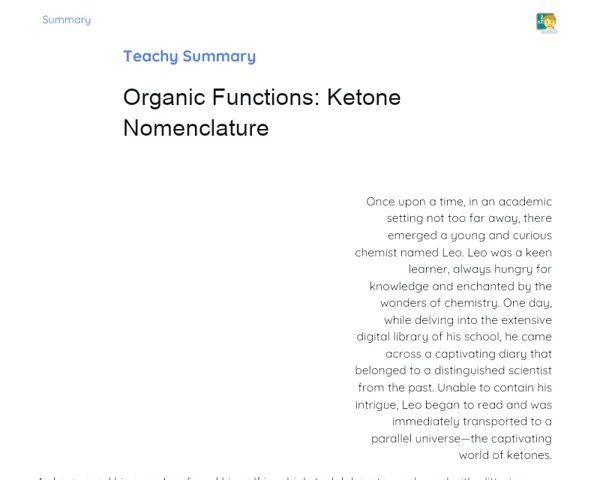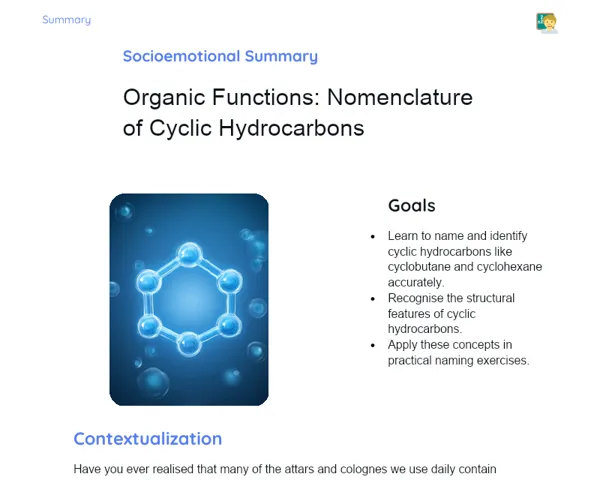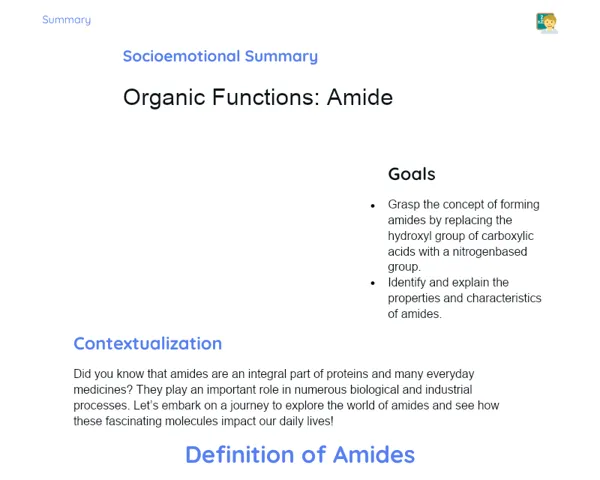Summary Tradisional | Organic Functions: Acyl Halide Nomenclature
Contextualization
In Organic Chemistry, having a standardized nomenclature is key for effective communication among scientists. One such group of organic compounds that adheres to specific naming conventions is acyl halides. These compounds consist of an acyl group (RCO-) linked to a halogen like chlorine, bromine, or iodine. According to IUPAC nomenclature, acyl halides are named by replacing the '-oic' ending of the related carboxylic acid with '-oyl', followed by the name of the halogen. For instance, acetyl chloride (CH3COCl) is derived from acetic acid (CH3COOH). This standardization facilitates clear identification of compounds, enabling smooth information exchange among researchers and practitioners in the field.
Acyl halides are extensively utilized in synthesizing pharmaceuticals and advanced materials, underscoring their practical significance. For example, the production of aspirin, one of the most widely used pain relievers in the world, involves an acyl halide. Furthermore, these compounds play a vital role in manufacturing polymers and other industrial materials. Grasping the nomenclature of acyl halides is not just important for studying Organic Chemistry but also for their practical uses across various scientific and technological domains.
To Remember!
Definition and Structure of Acyl Halides
Acyl halides are organic compounds featuring an acyl group (RCO-) connected to a halogen (Cl, Br, I, etc.). The general structure of an acyl halide can be depicted as R-CO-X, where 'R' represents an alkyl or aryl group, 'CO' symbolizes a carbonyl group, and 'X' stands for a halogen. These compounds are derived from carboxylic acids, with the hydroxyl group (-OH) of the acid replaced by a halogen. This structural change imparts distinct chemical and physical properties to acyl halides in comparison to their corresponding carboxylic acids.
Due to the presence of the carbonyl group, acyl halides exhibit high reactivity, making the adjacent carbon prone to nucleophilic attacks. This characteristic is leveraged in several organic synthesis reactions, positioning acyl halides as valuable intermediates in generating other chemical compounds. The Friedel-Crafts reaction, for instance, uses acyl halides to introduce acyl groups into aromatic rings, forming aromatic ketones.
Additionally, acyl halides generally have lower boiling and melting points than carboxylic acids because they lack intermolecular hydrogen bonding. This trait often allows many acyl halides to exist as liquids at room temperature, simplifying their handling in industrial applications. Nonetheless, their high reactivity necessitates careful handling and storage.
-
Acyl halides have an acyl group (RCO-) bonded to a halogen (Cl, Br, I, etc.).
-
They arise from carboxylic acids by substituting the hydroxyl group (-OH) with a halogen.
-
They are highly reactive and utilized in diverse organic synthesis reactions, like the Friedel-Crafts reaction.
IUPAC Nomenclature of Acyl Halides
The IUPAC nomenclature of acyl halides is meticulous and follows specific guidelines to ensure precise identification of these compounds. To name an acyl halide, one begins with the name of the related carboxylic acid. The suffix '-oic' of the acid is replaced by '-oyl', followed by the name of the halogen. For example, to name acetyl chloride (CH3COCl), we take acetic acid (CH3COOH), substitute '-oic' with '-oyl', resulting in acetyl, and then add 'chloride'.
This nomenclature system promotes clear identification of the origin of the acyl halide, enhancing communication among scientists and professionals in the field. Standardization is vital to prevent misunderstandings and ensure that everyone has a uniform understanding of the structure and properties of the compound discussed. Moreover, nomenclature may also incorporate prefixes and suffixes to denote the presence of substituents or specific functional groups in the carbon chain.
Another example is benzoyl chloride (C6H5COCl), derived from benzoic acid (C6H5COOH). Here, the '-oic' ending of benzoic acid is replaced by '-oyl', leading to benzoyl, with 'chloride' added. This naming approach is consistently applied to all acyl halides, regardless of the carbon chain's size or complexity.
-
IUPAC nomenclature of acyl halides begins with the name of the corresponding carboxylic acid.
-
The '-oic' ending of the acid changes to '-oyl', followed by the halogen's name.
-
Examples include acetyl chloride (CH3COCl) and benzoyl chloride (C6H5COCl).
Practical Examples of Acyl Halides
Acyl halides are versatile compounds extensively employed in different branches of chemistry. A well-known example is acetyl chloride (CH3COCl), used in synthesizing pharmaceuticals, dyes, and perfumes. It is also a key reagent in acylation reactions, where it introduces acetyl groups (CH3CO-) into target molecules, thus altering their chemical and biological characteristics.
Another notable example is benzoyl chloride (C6H5COCl), vital for producing polymers and resins. It acts as an intermediate in synthesizing organic peroxides used as polymerization initiators in industries. This compound is also involved in creating anti-inflammatory and antiseptic medications, showcasing its significance in the pharmaceutical sector.
Formyl chloride (HCOCl) is yet another acyl halide utilized as an intermediate in various organic syntheses. Although less common than the previous examples, formyl chloride plays a role in producing formamides and other derivatives. Its high reactivity mandates careful handling but allows the efficient introduction of the formyl group (HCO-) into organic compounds.
-
Acetyl chloride (CH3COCl) is used in creating pharmaceuticals, dyes, and perfumes.
-
Benzoyl chloride (C6H5COCl) plays a crucial role in producing polymers, resins, and medicines.
-
Formyl chloride (HCOCl) serves as an intermediate in producing formamides and formyl derivatives.
Difference between Acyl Halides and Other Organic Compounds
Acyl halides exhibit unique structural traits and chemical properties distinguishing them from other organic compounds like alcohols, ketones, and carboxylic acids. A primary distinction is the presence of the acyl group (RCO-) paired with a halogen, which confers high reactivity to acyl halides. This reactivity is particularly significant in acylation reactions, wherein acyl halides are exploited to introduce acyl groups into other molecules.
On the other hand, alcohols comprise a hydroxyl group (-OH) linked to a saturated carbon atom. They display different physical and chemical characteristics from acyl halides, such as higher boiling points due to the capability of forming hydrogen bonds. Ketones consist of a carbonyl group (C=O) attached to two alkyl or aryl groups, whereas carboxylic acids contain a carboxyl group (COOH) that can establish intermolecular hydrogen bonds, leading to elevated boiling points and enhanced water solubility.
In contrast to acyl halides, carboxylic acids are less reactive due to the resonance stabilization of their carboxyl group. By replacing the hydroxyl group with a halogen, acyl halides lose this stabilization, rendering the carbon adjacent to the carbonyl more prone to nucleophilic attacks. This fundamental distinction in structure and reactivity underpins the use of acyl halides in particular organic syntheses.
-
Acyl halides contain an acyl group (RCO-) bonded to a halogen.
-
Alcohols have a hydroxyl group (-OH) linked to a saturated carbon.
-
Ketones feature a carbonyl group (C=O) connected to two alkyl or aryl groups.
-
Carboxylic acids include a carboxyl group (COOH) that is capable of forming intermolecular hydrogen bonds.
Key Terms
-
Acyl Halides: Organic compounds that have an acyl group (RCO-) linked to a halogen (Cl, Br, I, etc.).
-
Acyl Group: Functional group (RCO-) found in acyl halides, originating from carboxylic acids.
-
IUPAC Nomenclature: Standardized system for naming chemical compounds, employed for acyl halides.
-
Acetyl Chloride: Acyl halide (CH3COCl) derived from acetic acid, utilized in organic synthesis.
-
Benzoyl Chloride: Acyl halide (C6H5COCl) derived from benzoic acid, significant for producing polymers and medicines.
-
Carboxylic Acids: Organic compounds encompassing a carboxyl group (COOH), from which acyl halides derive.
-
Reactivity: The potential of acyl halides to engage in chemical reactions, notably acylation.
-
Friedel-Crafts Reaction: A reaction that employs acyl halides to insert acyl groups into aromatic rings, yielding aromatic ketones.
Important Conclusions
Acyl halides are fundamental organic compounds in Organic Chemistry, characterized by an acyl group (RCO-) tethered to a halogen (Cl, Br, I, etc.). The systematic IUPAC nomenclature for these compounds substitutes the '-oic' ending of the related carboxylic acid with '-oyl', followed by the halogen's name, evident in compounds like acetyl chloride and benzoyl chloride.
Due to their high reactivity, acyl halides are crucial intermediates in numerous organic synthesis reactions, including the creation of pharmaceuticals and advanced materials. Comprehending the structure and nomenclature of these compounds is vital for accurate scientific dialogue, mitigating misunderstandings, and facilitating the smooth exchange of information among chemistry practitioners.
Moreover, studying acyl halides enables a clear distinction from other functional groups such as alcohols, ketones, and carboxylic acids, reinforcing the significance of a detailed understanding of structural characteristics and chemical behaviors in Organic Chemistry. This knowledge serves as a foundation for practical applications and future scientific inquiries.
Study Tips
-
Review practical examples of acyl halides and practice naming new compounds to reinforce IUPAC nomenclature.
-
Compare the structure and reactivity of acyl halides against other organic compounds like alcohols and ketones to strengthen understanding of the differences.
-
Look into scientific articles and supplementary educational resources regarding the application of acyl halides in the pharmaceutical and materials industries to enhance your practical knowledge.



